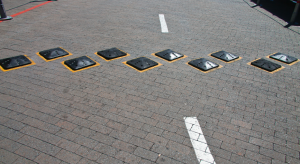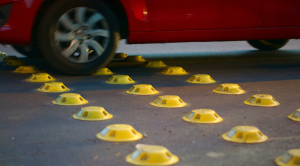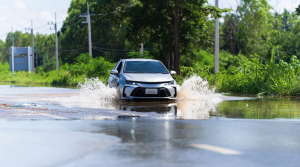Have you ever driven through a neighbourhood with speed bumps, roundabouts, or other traffic calming measures? These measures are put in place to slow down traffic and make the roads safer for pedestrians and residents. But do you know how to navigate these areas effectively and safely? In this blog, we will explore what traffic calming measures are, when they are effective, and whether they are safe. We will also provide tips on how you should drive in areas with traffic calming measures to ensure the safety of everyone on the road. So buckle up and get ready to become an expert in navigating these unique driving situations.
What Are Traffic Calming Measures?

Traffic calming measures are designed to reduce traffic congestion and improve the livability of an area. Traffic calming devices can include speed bumps, street narrowing or closing, and landscaping. Traffic calming measures have been shown to be effective in reducing both traffic congestion and automobile collisions.
When are Traffic Calming Measures Effective?

Traffic calming measures can be effective in a variety of situations. They are most commonly used in residential areas and school zones where there is a high volume of pedestrian and vehicle traffic. These measures, such as speed bumps, roundabouts, and air traffic islands, are designed to slow down vehicles and improve safety for pedestrians. Traffic calming measures can also be effective in reducing accidents and injuries in areas with high speeds or frequent accidents.
They can also help create a more pleasant and livable environment by reducing noise and air pollution. However, it is important to note that the effectiveness of traffic calming measures may vary depending on their specific circumstances and design. It is crucial to carefully assess the situation and implement appropriate measures based on thorough analysis and consultation with traffic engineering experts.
Are Traffic Calming Measures Safe?

Traffic calming measures are generally considered to be safe and effective in reducing speeding and improving road safety. These measures, such as speed bumps, roundabouts, and traffic islands, are designed to slow down vehicles and create a safer environment for pedestrians and cyclists. However, it is important to note that the safety of traffic calming measures can depend on their design and implementation.
Poorly designed or improperly installed measures can potentially pose risks to motorists, cyclists, and pedestrians. Therefore, it is crucial for local authorities and transportation agencies to carefully plan and implement traffic calming measures to ensure they are safe and effective in their intended purpose of improving road safety.
Regular monitoring and evaluation of these measures can also help identify any safety concerns and make necessary adjustments or improvements as needed.
How Should You Drive in Areas With Traffic Calming Measures?

When navigating through areas with traffic calming measures, it is important to adapt your driving style for the safety of both yourself and other road users. These measures are designed to slow down traffic and create a safer environment for pedestrians and cyclists. Here are some tips on how to drive in such areas:
1. Observe the Speed Limit: Traffic calming measures often include reduced speed limits. Ensure you adhere to these limits and maintain a safe speed that allows you to react to unexpected situations.
2. Stay Alert: Keep an eye out for various traffic calming devices such as speed bumps, chicanes, raised crossings, or road narrowing. These devices are meant to slow down traffic, so be prepared to adjust your speed accordingly.
3. Look out for Pedestrians and Cyclists: Traffic calming measures are usually implemented in areas with high pedestrian or cyclist activity. Be extra cautious and watch out for pedestrians crossing the road or cyclists navigating through the area.
4. Be Patient: Understand that traffic calming measures may cause delays or slower-moving traffic. Stay patient and avoid aggressive driving behaviour such as tailgating or excessive lane changing.
5. Follow Road Markings and Signs: Pay attention to any additional road markings or signs related to the traffic calming measures. These may indicate specific rules or restrictions that you need to follow, such as no overtaking or designated pedestrian zones.
6. Maintain a Safe Following Distance: Keep a reasonable distance between your vehicle and the one in front of you. This allows for more time to react and brake if necessary, especially considering the reduced speeds in traffic-calming areas.
Which Areas Use Traffic Calming Measures?

Traffic calming measures can be used in a variety of areas, from congested urban cores to suburban neighbourhoods. Which areas use traffic calming measures varies depending on the location and purpose of the measure. Some common types of traffic calming measures include turning lanes, speed humps, painted islands, and medians.
Turning lanes are typically used in areas where vehicles exiting or entering the area must cross multiple lanes of traffic. Turning lanes can help reduce congestion by allowing drivers to use available space more efficiently.
Speed humps are typically placed at intersections where vehicular traffic frequently travels above the posted speed limit. Speed humps help slow down drivers and create a more comfortable driving experience for pedestrians and other drivers.
Painted islands are often used as visual reminders for drivers to slow down. Painted islands can also serve as jumping-off points for crossing busy intersections, reducing the need for motorists to stop at an intersection altogether.
Medians can effectively reduce traffic congestion in two ways: by slowing down cars near the median and causing slower-moving cars approaching the median to merge onto narrower streets nearby instead of pulling into the median lane themselves.
Conclusion
In conclusion, driving in areas with traffic calming measures requires patience, attentiveness, and adherence to the designated rules. Slow down when approaching speed bumps, chicanes, or roundabouts, and be aware of any signage or road markings indicating traffic calming measures. Keep a safe distance from other vehicles and be prepared for sudden stops or changes in traffic flow. It is important to respect the purpose of these measures to enhance safety for pedestrians and reduce the risk of accidents. By driving responsibly and following the guidelines, you contribute to creating a safer and more harmonious traffic environment for everyone. Stay alert, stay cautious, and help make our roads a better place for all.









